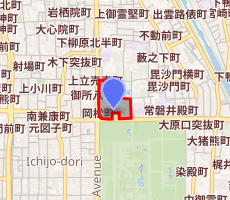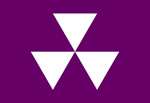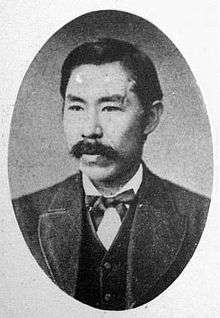Doshisha University
Doshisha University (同志社大学, Dōshisha daigaku), also referred to as Dodai (同大, Dōdai), is a private university in Kyoto City, Japan. Doshisha University is one of the most prestigious universities in Japan today, with particularly strong influence in the Kansai region, and is considered one of the most selective private universities in Japan.[1][2][3] The acceptance rate for the 40,924 applicants for the 2014 academic year was 35.6%, with acceptance rate in some departments under 15%.[4] In 2013, the university was ranked fourth among Japanese private universities for "schools to which parents wish to send their child," following Waseda University, and Keio University in Tokyo.[5]
同志社大学 | |
  Map around Imadegawa
Map around Imadegawa | |
| Motto | Latin: Veritas liberabit vos |
|---|---|
Motto in English | Truth shall make you free |
| Type | Private |
| Established | Founded 1875, Chartered 1920 |
| Endowment | €1 billion (JP¥169.6 billion) |
| President | Matsuoka Takashi |
| Vice-president | Nobuhiro Tabata, Yasuhiro Kuroki, Tsutao Katayama, Takashi Nishimura |
Academic staff | 2,357 (800 full-time, 1557 part-time) |
| Undergraduates | 27,024 |
| Postgraduates | 2,298 |
| Location | Kyoto , , 35°01′47″N 135°45′39″E |
| Campus | Urban / Suburban, 530 acres (2.1 km²) |
| Colors | White and Purple |
| Athletics | 50 varsity teams |
| Nickname | Dodai (同大, Dōdai) |
| Mascot | Astro Boy (unofficial and historical) |
| Website | www |
 | |
Established in 1875, it is one of Japan's oldest private institutions of higher learning, and has approximately 30,000 students enrolled on four different campuses in Kyoto.[6] It is one of the Japanese "Global 30" universities[7] and one university belonging to "Kankandoritsu" (関関同立), a group of the four leading private universities in western Japan's Kansai region.
History

Doshisha University was founded in 1875 as Doshisha English School by Protestant educator Niijima Jō (新島 襄, also known as Joseph Hardy Neesima), as a school to advance Christian education in Japan. As a young man, Niijima left Japan for the United States in 1864, despite the ban on overseas travel then imposed on Japanese nationals. He studied at Phillips Academy and Amherst College, and returned to Japan in 1874. The next year, Niijima established the Doshisha School. Niijima served as president of the university from 1875 to 1890. Other early university presidents included educator and author Yamamoto Kakuma (1890–1892), Seito Saibara (1899–1902), who was the first Christian member of the Japanese Diet, and prominent chemical engineer Kotaro Shimomura (1904-1907).
By 1920, Doshisha was granted university status and developed into a full-fledged university in the Anglo-American academic tradition. During World War II, its buildings were given Japanese names and its curriculum was stripped of its pro-Western elements. The prewar conditions were restored after the surrender of Japan. The first graduate degree programs were instituted in 1953.
Amherst College has maintained a close relationship with Doshisha University,[8] and since 1972, Doshisha has collaborated with a consortium of American liberal arts colleges including Amherst to host the Associated Kyoto Program, an 8-month long study abroad program offered every year to students from American colleges and universities. Doshisha also houses the Kyoto Consortium for Japanese Studies, another program affiliated with American universities and centered on advanced Japanese language training.
Academics and admissions
| Toyo Keizai National[9] | General | 18 |
|---|---|---|
| WE National[10] | Employment | 18 |
| NBP Kansai[11] | Reputation | 3 (#1 private) |
| Shimano National[12] | Selectivity | A1 |
| LAW | ||
|---|---|---|
| BE Success National[13] | Qualification | 11 |
| BE Pass rate National[14] | Qualification | 23 |
| BUSINESS & MANAGEMENT | ||
| CPA Success National[15] | Qualification | 9 |
Doshisha has graduate degree programs in Theology, Letters, Psychology, Business, Global Studies, Law, Economics, Commerce, Policy and Management, Culture and Information Science, Science and Engineering, Life and Medical Sciences, Health and Sports Science, and Social Studies.[16]
The libraries at the Imadegawa and Kyotanabe campuses hold more than 2.5 million volumes.
Faculty
As of 2013, Doshisha University employs 777 full-time and 1,411 part-time faculty members across its Kyoto campuses. In terms of research, Doshisha has filed the 36th-highest number of patents in the nation.[17]
Campuses
Doshisha University has two main campuses at Imadegawa in central Kyoto and at Kyotanabe in southern Kyoto. Imadegawa is the main campus, located in the former residence of Satsuma Domain. It has been in use since the school was founded. Located in the center of Kyoto City, the campus is situated next to Shōkoku-ji, overlooking Kyoto Imperial Palace. Five buildings in the Imadegawa campus have been designated as Important Cultural Properties of Japan, including Doshisha Chapel and Clark Memorial Hall. This campus is primarily for the liberal arts, business (including a graduate school of business), theology, and law faculties. A large learning commons with over 40,000 square meters of space, the Ryoshinkan, was opened in 2012 and included the incorporation of Imadegawa Station, a station on the Karasuma Line of the Kyoto Municipal Subway.
The Kyotanabe Campus was opened in 1986, in Kyōtanabe, Kyoto and is part of Kansai Science City. Over 195 acres (0.79 km2) in area, it serves primarily as the campus for the science and engineering faculties. In 2012, a new Karasuma Campus was established approximately 300 meters from the Imadegawa Campus. The Karasuma Campus houses the International Education Institute, the Graduate School of Global Studies, and the Faculty of Global and Regional Studies.
 Doshisha Chapel, Imadegawa
Doshisha Chapel, Imadegawa Clark Memorial Hall, Imadegawa
Clark Memorial Hall, Imadegawa- The Learned Memorial Library, Kyotanabe
- Mukokukan, Kyotanabe
Student life
Societies
There are over 400 clubs and organizations in Doshisha University.[18]
Festivals
- Doshisha Eve
- Doshisha Kyotanabe Festival
- Sports Festival
Athletics
- Doshisha is part of the Kansai Big Six Baseball League. The baseball team is known for their rivalry with Ritsumeikan University.
- Doshisha's rugby team has a long history, and had won 4 championships in All-Japan University Rugby Championship from 1980 to 1984.[19]
- The men's basketball program is noted for its frequent participation in All Japan Intercollegiate Basketball Championship.
Alumni
Doshisha is renowned for its strong connection to business in the Kansai region, and according to the 2011 university rankings by Toyo Keizai, 533 alumni served as executives in listed companies. As of 2013, around 25.5% of undergraduates were able to enter one of the top 400 companies in Japan, which ranks eighth nationwide among all private institutions in Japan and first among private universities in Kansai.[20]
Doshisha alumni include Takako Doi, the first female Lower House Speaker in Japan (the highest position a female politician has held in the country's history); Abe Isoo, an early pacifist and feminist and member of the Japanese Diet; Japanese statesman Uchida Kosai, who twice served as acting prime minister; Japanese-language author David Zoppetti; Korean poet Yun Dong-ju; tea master Hansō Sōshitsu; and Gunpei Yokoi, creator of the Nintendo Game Boy.
References
- National and Public universities apply different kind of exams.
- e.g. Yoyogi seminar published Hensachi (the indication showing the entrance difficulties by prep schools) rankings "Archived copy". Archived from the original on 2011-04-22. Retrieved 2016-07-29.CS1 maint: archived copy as title (link)
- Japanese journalist Kiyoshi Shimano ranks its entrance difficulty in the "most selective" bracket in Japan. 危ない大学・消える大学 2012年版 (in Japanese). YELL books. 2011.
- https://www.doshisha.ac.jp/attach/page/OFFICIAL-PAGE-JA-1711/39645/file/genroubetu.pdf%5B%5D
- "大学通信キャンパスナビ ネットワーク - 2013年 社会人が評価する大学ランキング 私立大学編". Retrieved 6 May 2019.
- "About Doshisha: Fact". Doshisha University. Retrieved July 21, 2013.
- "Selection results - Project for Establishing University Network for Internationalization (Global 30) - Japan Society for the Promotion of Science". www.jsps.go.jp. Retrieved 6 May 2019.
- "The Doshisha University". Amherst College. Archived from the original on October 24, 2015. Retrieved July 21, 2013.
- "Truly Strong Universities" (in Japanese). Toyo Keizai. 2010. Retrieved April 29, 2011.
- "Employment rate in 400 major companies rankings" (in Japanese). Weekly Economist. 2011. Retrieved April 29, 2011.
- "Nikkei BP Brand rankings of Japanese universities" (in Japanese). Nikkei Business Publications. 2010. Retrieved April 29, 2011.
- "GBUDU University Rankings" (in Japanese). YELL books. 2009. Retrieved April 29, 2011.
- "Bar Exam Successful Applicants rankings" (in Japanese). Shikaku Seek. 2010. Retrieved May 11, 2011.
- "Bar Exam Pass rate rankings" (in Japanese). Shikaku Seek. 2010. Retrieved May 11, 2011.
- "CPA Successful Applicants rankings" (in Japanese). Yutaka Honkawa. 2010. Retrieved May 11, 2011.
- http://intad.doshisha.ac.jp/en/inbound/guide_entrance_exam.html
- http://www.jpo.go.jp/shiryou/toushin/nenji/nenpou2010/toukei/2-13.pdf
- "Doshisha University Clubs and Circles". Doshisha University. Retrieved July 21, 2013.
- "Doshisha University Rugby Football Club: Information". Doshisha University. Retrieved July 21, 2013.
- "2013年 大学別著名400社 就職率ランキング". 大学通信. Archived from the original on October 29, 2014. Retrieved October 29, 2014.
External links
| Wikimedia Commons has media related to Doshisha University. |